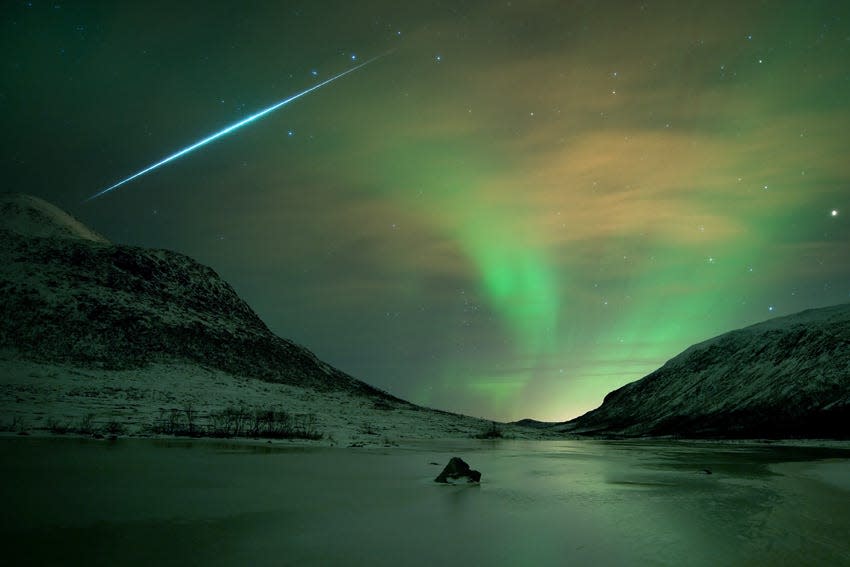Geomagnetic storm hurtles into Earth's atmosphere, brings danger of power grid interference
Read the latest on the northern lights this weekend: Saturday's forecast says parts of U.S. could see auroras.
A geomagnetic storm that's now hurtling into the Earth has been classified as "extreme," or a G5 storm, the highest level, the Space Weather Prediction Center said Friday evening. It's the first G5 storm to hit our planet since 2003.
Due to the extreme storm, power grid irregularities are possible, along with potential impacts to HF/VHF/UHF communications, GPS, satellite navigation, and other technologies, the prediction center said. Critical infrastructure operators have been notified.
The last extreme (G5) event occurred in October 2003, which resulted in power outages in Sweden and damaged transformers in South Africa.
See the amazing photos: The northern lights were on full display across US, Europe on Friday
Aurora borealis might be seen over much of the U.S.
Skywatchers get ready: Thanks to the unusually strong solar activity, the aurora borealis should be coming to the skies above a large portion of the United States this weekend, space weather forecasters said Friday.
Federal forecasters from NOAA's Space Weather Prediction Center said that during previous solar activity of this magnitude, the "aurora has been seen as low as Alabama and northern California." NOAA experts said the aurora might be visible Friday, Saturday or Sunday nights.
"This is an unusual and potentially historic event," said Clinton Wallace, director of the Space Weather Prediction Center, in a statement.
Coronal mass ejections coming from the sun
The spectacle would be courtesy of a series of at least seven coronal mass ejections (CMEs) from the sun, which are forecast to reach the Earth early this weekend and produce the geomagnetic storms that trigger auroras. A rare G4 (severe) geomagnetic storm watch remained in effect for Saturday, May 11, NOAA said.
Friday afternoon, G4 conditions were observed by the Space Weather Prediction Center, and "significant to severe geomagnetic storming is likely to continue," the center said.
More details will be known about the severity of the event and the possible extent of the aurora later Friday evening as the first CME approaches the Earth, Shawn Dahl, a space weather forecaster at SWPC, told reporters Friday morning during a news briefing.
The northern lights are the most benign result of solar activity. Strong solar storms – including G4s – can also disrupt some radio communications, harm satellites and even knock out power systems, forecasters warned.

Storm watch upgraded to rare G4 ? the first since 2005
"This weekend's geomagnetic storm watch has been upgraded from G2 (Moderate) to G4 (Severe)," according to astronomer Tony Phillips, writing on SpaceWeather.com. "Why? Because giant sunspot AR3664 keeps hurling CMEs toward Earth. Following today's X2.2 solar flare, there are now at least 4 storm clouds heading our way," Phillips said.
The Space Weather Prediction Center only rarely issues "severe" storm watches. The last time such an alert was issued was January 2005. "Watches at this level are very rare," the center said.
The colorful aurora forms when particles flowing from the sun get caught up in Earth's magnetic field. The particles interact with molecules of atmospheric gases to cause the famed glowing green and reddish colors of the aurora.
More details: When could you see the northern lights? Aurora forecast for over a dozen states this weekend
Auroras are notoriously a fickle forecast
The aurora can be fickle to forecast, so some caution is warranted before adjusting your weekend plans. Unlike terrestrial weather, scientists who forecast space weather – which includes the aurora – must rely on observations of the 93-million-miles-away sun to make their predictions.
"There are so many uncertainties, it makes it difficult to predict," Bill Murtagh, the program coordinator at the Space Weather Prediction Center, told USA TODAY last year. And as hard as it is to forecast weather here on Earth, "we are decades behind the forecast capabilities of our colleagues in meteorology," he admitted, referring to space weather.
Solar maximum is here
The northern lights, aka the aurora borealis, have been appearing more frequently in the night sky over the United States recently. In April 2023, for example, a stunning aurora display was seen as far south as Arkansas in the South and Arizona in the West.
So why the uptick in aurora sightings? And is this expected to continue? Well, if you love the aurora, you're in luck, as it may be coming to a sky near you more often over the next few years thanks to the "solar maximum," which is expected to peak this year.
"There have been an increase in aurora seen in general on Earth," Shannon Schmoll, the director of the Abrams Planetarium at Michigan State University told USA TODAY last year. "The sun has been more active, resulting in more solar storms that cause solar flares and coronal mass ejections (CME).
Tips for viewing the northern lights
"Go out at night," NOAA said. "And get away from city lights."
The best aurora is usually within an hour or two of midnight (between 10:00 p.m. and 2:00 a.m. local time). These hours expand towards evening and morning as the level of geomagnetic activity increases.
There may be aurora in the evening and morning, but it is usually not as active and therefore, not as visually appealing, NOAA said.
Where will the weather cooperate for aurora viewing?
The best viewing conditions for the aurora are expected across the northern Plains and the Pacific Northwest, where mainly cloud-free conditions will lead to great views of the night sky, AccuWeather meteorologist Brian Lada said.
"Clouds will be a bigger issue for folks across the Northeast and part of the Midwest, although there could be a pocket around the Ohio Valley where breaks in the clouds will allow some views of the aurora," he said.
This article originally appeared on USA TODAY: Geomagnetic storm threatens power grids, GPS, radio waves across Earth
